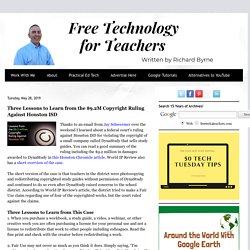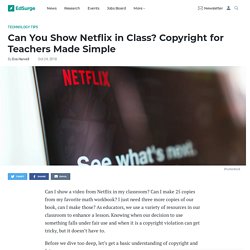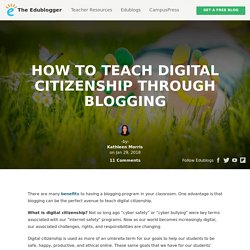

Three Lessons to Learn from the $9.2M Copyright Ruling Against Houston ISD. Thanks to an email from Jay Schwermer over the weekend I learned about a federal court's ruling against Houston ISD for violating the copyright of a small company called DynaStudy that sells study guides.

You can read a good summary of the ruling including the $9.2 million in damages awarded to DynaStudy in this Houston Chronicle article. World IP Review also has a short overview of the case. The short version of the case is that teachers in the district were photocopying and redistributing copyrighted study guides without permission of DynaStudy and continued to do so even after DynaStudy raised concerns to the school district.
According to World IP Review's article, the district tried to make a Fair Use claim regarding use of four of the copyrighted works, but the court ruled against the claims. Teaching Copyright. Circ21. Copyright in an Electronic Environment. Can You Show Netflix in Class? Copyright for Teachers Made Simple. Can I show a video from Netflix in my classroom?

Can I make 25 copies from my favorite math workbook? I just need three more copies of our book, can I make those? As educators, we use a variety of resources in our classroom to enhance a lesson. Knowing when our decision to use something falls under fair use and when it is a copyright violation can get tricky, but it doesn’t have to. Before we dive too deep, let’s get a basic understanding of copyright and fair use. What is Copyright? According to copyright.gov, copyright is “a form of protection grounded in the U.S. What is Fair Use? Fair use permits the unlicensed use of copyright-protected works in certain circumstances. The purpose and character of the use;the nature of the copyrighted work;the amount and substantiality of the portion use in relation to the whole work; andthe effect of the use upon the potential market.
Printed materials, like books and articles, do fall under fair use in some cases—but this can be flexible. Apr 22, 2018 11:07 AM.webm. Welcome.
How To Teach Digital Citizenship Through Blogging. There are many benefits to having a blogging program in your classroom.

One advantage is that blogging can be the perfect avenue to teach digital citizenship. What is digital citizenship? Not so long ago “cyber safety” or “cyber bullying” were key terms associated with our “internet safety” programs. Now as our world becomes increasingly digital, our associated challenges, rights, and responsibilities are changing. Digital citizenship is used as more of an umbrella term for our goals to help our students to be safe, happy, productive, and ethical online.
Common Sense Media’s curriculum identifies eight topics under the umbrella of digital citizenship including: internet safety, cyberbullying, copyright and more. Empowering your students with skills to think critically, behave safely, and participate responsibly online, allowing them to connect and collaborate in meaningful ways. All teachers know how important digital citizenship is. But how do we teach digital citizenship? 1) Netiquette. A new twist on cyberbullying.
Turning Your Students Into Web Detectives. Our students use the web every day—shouldn’t we expect them to do better at interpreting what they read there? Perhaps, but not necessarily. Often, stereotypes about kids and technology can get in the way of what’s at stake in today’s complex media landscape.
Sure, our students probably joined Snapchat faster than we could say “Face Swap,” but that doesn’t mean they’re any better at interpreting what they see in the news and online. As teachers, we’ve probably seen students use questionable sources in our classrooms, and a recent study from the Stanford History Education Group confirms that students today are generally pretty bad at evaluating the news and other information they see online. Now more than ever, our students need our help. In a lot of ways, the web is a fountain of misinformation. Here’s a list of fact-checking resources you and your students can use in becoming better web detectives. FactCheck.org Download a student-friendly version here. PolitiFact Snopes. Digital Literacy.
Eli Pariser: Beware online "filter bubbles". Be Internet Awesome - Resources. Home - iKeepSafe. Teaching strategies and digital citizenship tools for educators.